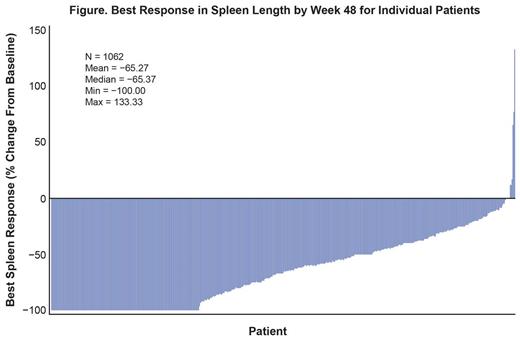Abstract
BACKGROUND
Ruxolitinib is a potent JAK1/JAK2 inhibitor that has demonstrated reductions in splenomegaly and disease-related symptoms, as well as improved survival, in patients with MF and has proved superior to placebo and best available therapy in the 2 phase 3 COMFORT studies. JUMP (JAK Inhibitor Ruxolitinib in Myelofibrosis Patients) is a phase 3b, expanded-access trial for countries with no access to ruxolitinib outside a clinical trial and was designed to assess the safety and efficacy of ruxolitinib in patients with MF. As of 03 June 2014, 2027 patients have been enrolled in 25 countries, with a planned enrollment of 2500 patients.
METHODS
Eligible patients had MF classified as high risk, intermediate (Int)-2 risk, or Int-1 risk, with a palpable spleen (≥ 5 cm from the costal margin). Patients received starting doses of ruxolitinib based on platelet counts at baseline (5 mg twice daily [bid; ≥ 50 to < 100 × 109/L], 15 mg bid [100 to 200 × 109/L], or 20 mg bid [> 200 × 109/L]). The primary endpoint was assessment of safety and tolerability of ruxolitinib. Additional analyses included changes in palpable spleen length and symptom scores as measured by the FACT-Lymphoma Total Score (FACT-Lym TS). The final analysis will be performed after all patients have completed 24 months of treatment or ended treatment due to commercial availability.
RESULTS
This analysis includes results for 1144 enrolled patients (primary MF, 58.8%; n = 673) who started treatment ≥ 1 year before the data cutoff date (01 Jan 2014). At baseline, median age was 68 y (range, 18-89 y); 46.7% were female; median palpable spleen length was 13 cm below the costal margin; median hemoglobin was 105 g/L (range, 44-200 g/L) and 40.3% of patients had hemoglobin levels ˂ 100 g/L; median platelet level was 256 × 109/L (75-1910 × 109/L); mean FACT-Lym TS was 41.9. Most patients (69%) remained on treatment (35.5%) or completed treatment per protocol (33.5%; transition to commercial drug). Primary reasons for discontinuation included adverse events (AEs; 13.8%), disease progression (7.1%), and death (3.8%).
Median exposure was 11.1 months; the median average daily dose was 37.2 mg for patients starting at 20 mg bid (64%; n = 728) and 23.4 mg for patients starting at 15 mg bid (33%; n = 374). The majority of patients (75.7%) had dose increases/decreases and 23.9% had a dose interruption.
The most common hematologic grade ≥ 3 AEs were anemia (33.0%), thrombocytopenia (12.5%), and neutropenia (3.9%), which led to discontinuation in 2.6%, 3.2%, and 0.3% of patients, respectively. Mean hemoglobin levels declined from baseline (108 g/L) to a nadir of 85 g/L at 8 to 12 weeks and increased to near-baseline levels after week 12; mean platelet levels decreased from baseline (318 × 109/L) to a nadir of 139 × 109/L and remained stable over time. The most common nonhematologic AEs (≥ 10%) were diarrhea (14.5%), pyrexia (13.3%), fatigue (12.9%), and asthenia (12.5%) and were primarily grade 1/2; grade ≥ 3 AEs were low overall (< 2%), except pneumonia (3.6%), which led to discontinuation in 6 patients (0.5%). Serious AEs were reported for 32.3% of patients. Rates of infections were low; all-grade infections ≥ 5% included nasopharyngitis (6.3%), urinary tract infection (6.0%), and pneumonia (5.3%). Tuberculosis was reported for 3 patients (0.3%; no grade 3/4); no hepatitis B was reported.
At weeks 24 and 48, 55% (431/782) and 61% (301/497) of patients achieved a ≥ 50% reduction from baseline in palpable spleen length, respectively; 23% (181/782) and 18% (88/497) had 25% to 50% reductions. Most patients (69%; 733/1062) experienced a ≥ 50% reduction in spleen length from baseline at any time (Figure). Clinically significant improvements on the FACT-Lym TS were seen as early as week 4 and were maintained at week 48 (mean change from baseline: week 4, 11.0; week 48, 9.4; the range for the minimally important difference is 6.5 to 11.2 points).
CONCLUSIONS
The JUMP study includes the largest cohort of MF patients treated with ruxolitinib reported to date. Consistent with previous reports, the most common AEs were anemia and thrombocytopenia; however, they rarely led to discontinuation. As observed previously, the majority of patients experienced reductions in spleen length and clinically meaningful improvements in symptoms were observed with ruxolitinib treatment. Overall, the safety and efficacy profile of ruxolitinib in JUMP is consistent with that in the phase 3 COMFORT studies.
le Coutre:Novartis: Honoraria, Research Funding; BMS: Honoraria; Pfizer: Honoraria; Ariad: Honoraria. Griesshammer:Shire: Honoraria; Novartis: Honoraria; Sanofi: Honoraria; Roche: Honoraria; Amgen: Honoraria. Schafhausen:Novartis: Membership on an entity's Board of Directors or advisory committees. Vannucchi:Novartis Pharmaceuticals Corporation: Consultancy, Honoraria, Research Funding. Foltz:Novartis: Consultancy, Honoraria, Research Funding; Incyte: Research Funding; Gilead: Research Funding; Promedior: Research Funding; Janssen: Consultancy. Gupta:Novartis: Consultancy, Honoraria, Research Funding; Incyte Corporation: Consultancy, Research Funding. Tannir:Novartis: Employment. Ronco:Novartis: Employment. Ghosh:Novartis: Employment. Al-Ali:Novartis: Consultancy, Honoraria, Research Funding; Celgene: Honoraria, Research Funding.
Author notes
Asterisk with author names denotes non-ASH members.


This feature is available to Subscribers Only
Sign In or Create an Account Close Modal